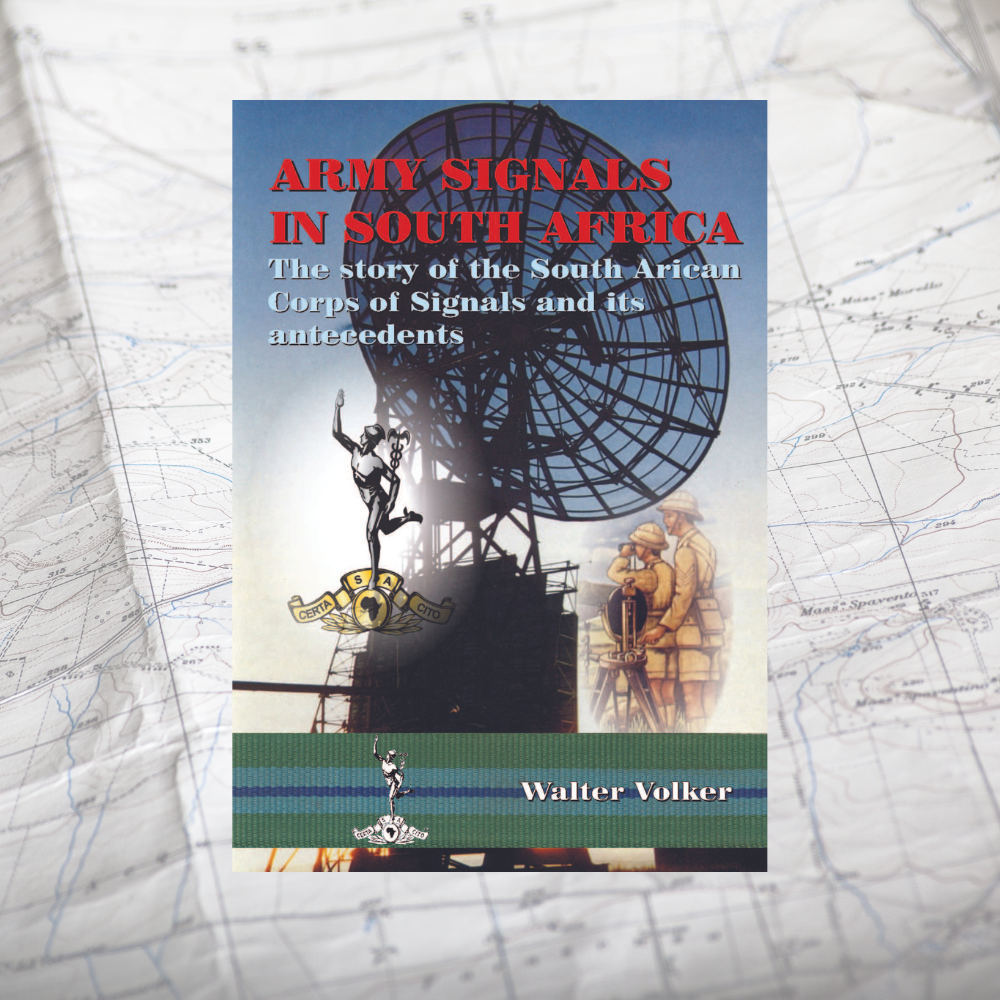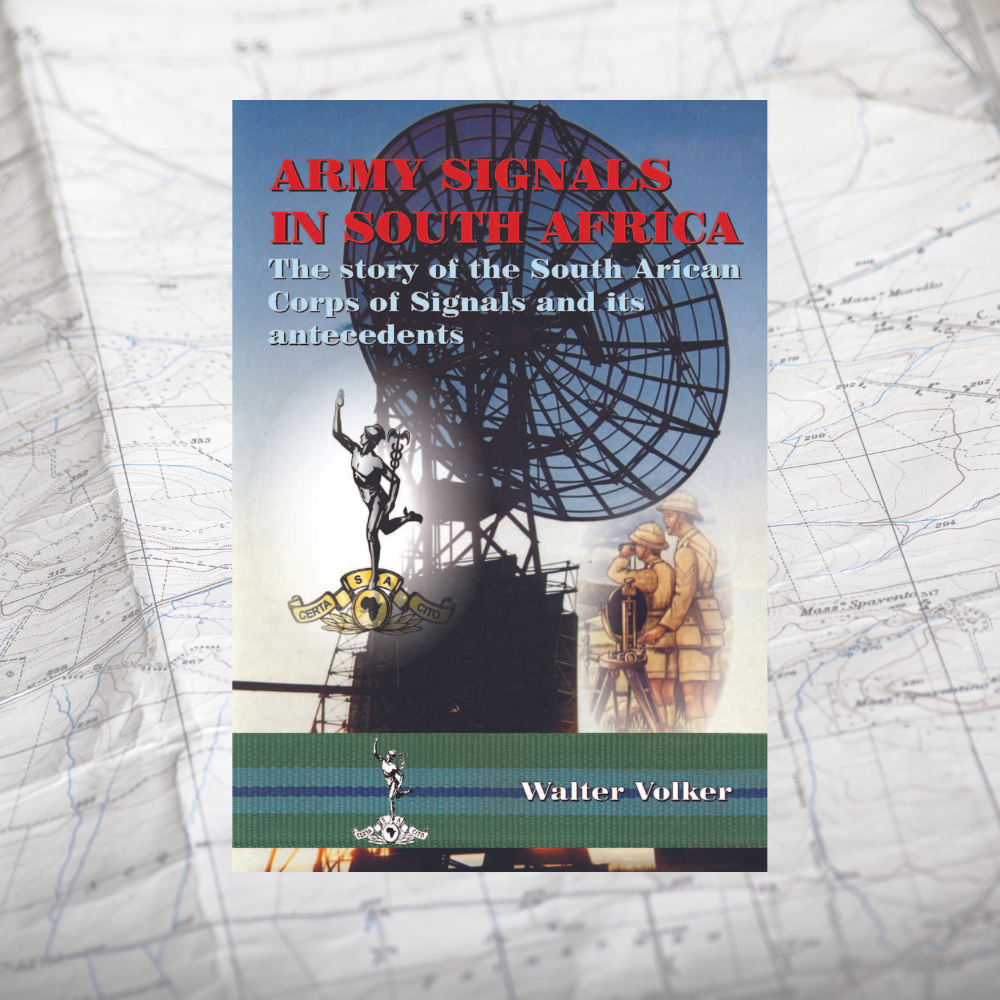Walter Volker
Army Signals in South Africa: The Story of the South African Corps of Signals and Its Antecedents (Volume 1 of the SACS Trilogy), Walter Volker
Army Signals in South Africa: The Story of the South African Corps of Signals and Its Antecedents (Volume 1 of the SACS Trilogy), Walter Volker
Couldn't load pickup availability
The book, entitled ARMY SIGNALS IN SOUTH AFRICA. The Story of the South African Corps of Signals and its antecedents is impressive work of epic proportions, and together with its two companion volumes, will most probably become the primary reference work on army signals in South Africa.
It is a compilation of some previously published material, but consists mainly of new material never before published, large parts which have come from verbal recollections, rather than documentation. It is the result of thorough and meticulous research, including over two hundred personal interviews, stretching over a period of many years. Interviewees range from a number of generals to the lowest troop, to ensure a level of authenticity and reality in all aspects of this history. The effect of including numerous personal accounts sprinkled throughout the pages of the book is that the history literally comes alive and creates a sense of personal experience and interest, rather than just a record of dry facts. The author has also ensured that names and places are mentioned wherever possibly, not just dates and events again this serves to give the account a greater level of human interest.
The book consists of a chronological sweep of the history of land-based signals in South Africa, starting with the role of the British army signallers and those of the independent Boer Republics before and during the Boer War, through the two world wars, then on through its climax during the Border War (1966 to 1989), the involvement of Military Intelligence in setting up the first Electronic Warfare stations, through to the modern era of incorporation of the liberation forces and independent homelands. The transformation resulting from being a part of the newly post-1994 SANDF is also covered in detail.
The books also contains one of the most comprehensive studies of ceremonial matters as far as they relate to the SA Corps of Signals and related signal units covering badges, flashes, mottoes, songs and traditions.
What makes this a worthwhile addition to the library of any student of military history, is the fact that the signals/communications role is relevant to almost every part of the military machine; as a consequence it provides a good overview of operational aspects as well as behind-the-scenes developments in terms of Electronic Warfare. The book also contains one of the most comprehensive lists of border operations yet published.
Softcover, 694 pages. FIRST EDITION - FIRST PRINT
TABLE OF CONTENTS
PART I: BACKGROUND AND EARLY HISTORY
1. Early Roots
2. Early British Signals
3. Early Signals in South Africa (1652 – 1880)
PART II: SA Signals during the Anglo-Boer Wars (1880 -1881 and 1899 – 1902)
4. Field Telegraphy in the South African Republic (ZAR)
5. Field Telegraphy in the OFS Republic State Artillery
6. British Signals during the Anglo-Boer War (1899-1902)
PART III: REORGANISATION AND UNIFICATION
7. Post-War Consolidation and Reorganisation
8. The Bhambatha Rebellion
9. Reorganisation and Unification
10. Establishment of the Union Defence Force (UDF) in 1912
PART IV: SA Signals during World War I (1914 – 1918)
11. The Campaign in German South West Africa
12. Confusion in German East Africa
13. The Signals in Europe
PART V: SA Signals between the Wars (1919 – 1939)
14. Motivation for a Signals Corps
15. Procurement of new Technical Equipment
16. A Signals Corps becomes a necessity
17. The Establishment of the South African Corps of Signals (SACS) in 1923
18. Inadequate Equipment
19. Problems with Establishment Tables are Resolved
20. The SACS liaises with the Outside World
21. Signals Equipment and Other Problems
22. The Radio Reserve of the UDF
23. Reorganisation of the UDF and SACS
24. Reorganisation of the SACS and early Training (1937-1940)
PART VI: SA Signals during World War II (1939 – 1945)
25. Signal Units in South Africa during World War II
26. The Development of Radar and the SSS
27. The Signals in East Africa
28. The War in the Desert
29. The Signals in Madagascar
30. 6 South African Armoured Division in Italy
PART VII: THE SACS DURING THE IMMEDIATE POST-WAR PERIOD FROM 1946 TO 1967
31. Demobilisation and Reorganisation (1946 to 1956)
32. Major Political Changes in 1948
33. Draft System introduced in 1953
34. Consolidation 1957 to 1959
35. The end of the Union Defence Force (UDF) (1912 – 1958) and the Establishment of the SA Defence Force (SADF) in 1958
36. Becoming a Republic in 1961
37. Permanent Force Units established in 1962 – 11 Signals Squadron
38. Additional Citizen Force Units established: 1964 to 1967
39. The Republic Celebrates 5 Year Anniversary in 1966 – 11 Signals Squadron contribution
40. The Post of Secretary of Defence abolished in 1967
41. National Service system adopted in 1967
42. Prelude to Insurgency 1957 to 1967 – Radio Freedom
43. The Role of Command Signal Squadrons/ Units
Part VIII: THE SACS IN THE “BORDER WAR” (1966 to 1989) and “STRUGGLE” PERIOD TO 1993
44. The start of the SWA Border War and Insurgency into South Africa
45. Development of an own Strategic and Tactical EW capability initiated in 1968
46. Development of HF and VHF Tactical Radios initiated in 1968
47. Establishment of 1 Signal Regiment in 1969
48. Republic Day 10 Year in 1971 – 1 Signal Regiment contribution
49. Rationalisation of Signal Unit Identification Numbers in 1971
50. Development of Static Command and Control Telecommunications Systems initiated in 1972 – Project Ebbehout
51. Establishment of 2 Signal Regiment, 3 Electronic Workshop and 4 Electronic Workshop in 1972
52. Golden Jubilee and the First and Only Brigade Parade of the SACS in 1973
53. Movement of the School of Signals and 1 Signal Regiment to Heidelberg in 1973
54. Adoption of the Army Gymnasium in 1973
55. The SADF takes over SAP Tasks in 1 Military Area, SWA in 1973
56. Development of a Mobile Command and Control Telecommunications Systems capability initiated in 1974 – Project Netor
57. Establishment of 1 SA Corps (7 Div and 8 Div) and their Signal Units in 1974
58. Establishment of the unconventional forces Commands and their Signal Units in 1974
59. Development of the MARNET System for the Commandos in 1974
60. Establishment of Staff Departments – Personnel, Intelligence and Logistics in 1975
61. National Service extended from 12 to 24 months in 1978
62. State Security Council (SSC) and Chief of Finance established in 1978
63. The Army Battle School established in 1978
64. The SAMS established as the Fourth Defence Force arm in 1979
65. The Laingsburg Flood and 20th Republic Day Celebrations in 1981
66. The Move to the Wonderboom Military Base in 1981
67. Establishment of 5 Signal Regiment in 1981
68. Establishment of the Signal Formation in 1982
69. Reorganisation of the Commands in 1983
70. Reorganisation of the Conventional Forces in 1983
71. Signing of the Nkomati Accord in 1984
72. Regional Conflict: The Contribution of the SACS during Border War Operations from 1966 to 1989
73. Peace Negotiations leading to the Independence for SWA/ Namibia and the end of the Border War 1988 to 1990
74. Other Cross-Border Operations in Neighbouring and Frontline States
75. The Role of the SACS during the height of the Internal “Struggle” and the Township Violence from 1984 to 1993
PART IX: REDEPLOYMENT AND DEMOBILISATION OF THE SACS FROM 1989 TO 1993
76. Op Agree: Withdrawal from SWA/ Namibia
77. Walvis Bay: Telecommunications and EW
78. Redeployment of Project Metal from SWA to the RSA
79. Major Political Changes
80. Reorganisation of Conventional Forces
81. Establishment of the National Peace Keeping Force Signal Unit
PART X: THE SACS DURING THE TRANSFORMATION PERIOD POST-1994
82. Political Transition
83. The end of the SA Defence Force (SADF) (1958 – 1994) and the establishment of the SA National Defence Force (SANDF) in 1994
84. Integration of MK, APLA and TBVC countries’ Military Forces
PART XI: TRANSFORMATION AND RESTRUCTURING: CENTRALISATION AND DECENTRALISATION FROM 1996 TO 2008
85. Transformation and Reorganisation of the SANDF (1996 – 1999)
86. Migration of the SA Corps of Signals and the Signals Formation to the new CMI Division in 1999
87. Downgrading the CMI Division to the CMI Formation in 2000
88. The Establishment of the CMIS Division in 2003
89. Peacekeeping Signals
90. Phasing out of the Commando System from 2003
91. Establishment of the role of the Government Information Technology Officer (GITO) in 2005
92. Decentralisation and Migration of SA Corps of Signals and the Signals Formation back to the SA Army in 2008
93. Conclusion and Post Mortem
PART XII: CEREMONIAL and HERALDIC
94. Background
95. Uniforms and Dress
96. Corps and Unit Insignia, Badges and Emblems
97. Corps Colours
98. Unit and National Colours
99. Corps and Unit Mottoes
100. Corps and Unit Songs
101. First Day Covers
102. Mascots
103. Customs, Distinctions and Traditions
ABOUT THE AUTHOR: Walter V. Volker is the Chief Executive Officer of the Payments Association of South Africa (PASA). Prior to this, he worked for Absa Bank for seventeen years, and before that he was with NCR Corporation for seven years.Walter was born and grew up in the south-eastern Transvaal town of Piet Retief. He started his national service in 1981 with basic training at 3 SA Infantry Battalion, but was later transferred to the Army Gymnasium in Heidelberg, where he also received his officers commission. He was then transferred to 2 Signal Regiment at Wonderboom as a Command and Control Communications officer. He continued being involved with 2 Signal Regiment during his Citizen Force years, with the last major operation being two months border duty in mid-1988 during Operation Prone, based at Ondangwa.He holds a B.Sc and an MBL degree, and is married to Trudie (ne du Toit). Walter has already published a number of books on genealogy, including The Cotton Germans of Natal (2007); this series represents his first published work in the area of military history. In 2012 he published Piet Retief Commando the Story of a Border Commando 1880 2007 and Boer War Stories of the Piet Retief Commando and District. |
Share


